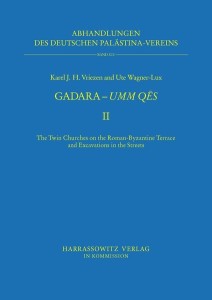
Karel J.H. Vriezen and Ute Wagner-Lux
Gadara–Umm Qēs II. The Twin Churches on the Roman–Byzantine Terrace and Excavations in the Streets
This volume is the second in the series on the archaeological exploration of ancient Gadara of the Decapolis (Umm Qēs, Jordan) by the German Protestant Institute for the Archaeology of the Holy Land (Amman). The book concentrates on the three areas excavated in cooperation with the Theological faculty of Utrecht University. The large terrace, down the slope of the upper city, approached from the city’s main street (decumanus maximus) was an urban focal area, overlooking the lower city. Its western retaining wall was buttressed by a line of rooms, with a street or a piazza in front. The original remains on the terrace, constructed in the 2nd century C.E., may have been from a large Roman forum basilica. In the 6th century the layout was completely remodelled into a Byzantine ecclesiastical compound, with a centralised church, a basilica and courtyards, which – concluding from the tombs and reliquaries found – may have served as a pilgrim’s centre. After the collapse of the terrace’s buildings, the street or piazza to the west remained in use through the Early Islamic – Mamluk times, as the Roman watersystem continued to attract people. In the centre of the lower city, part of the decumanus maximus was excavated, revealing earlier building remains underneath. In addition to the presentation of the excavated areas and their stratigraphy, the finds are described and discussed in separate contributions by various specialists on architecture, ceramics (Iron Age, Hellenistic – Mamluk periods), oil lamps, glass, coins, etc.
ISBN: 978-3-447-10452-4
Year: 2015
XII, 387 pages, 125 ill., 19 diagrams, 51 plates, 21 tables; 29,70 x 21,00 cm
89.00 Eur – Order from publishing house
Dieser Beitrag ist auch verfügbar in: German

